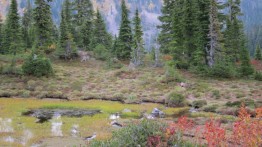What began as mere speculation has started to take a more serious turn. Climate change is now implicated in flooding, droughts, heat waves and other catastrophes that computer models predict will become more common. Suddenly, a region long mocked for its gloomy weather seems like it could be a welcome refuge from a hot, dry future. A UW graduate student recently took an in-depth look at the issue, which would have implications for the region’s long-term water supplies, transportation and other infrastructure.
Read more at UW Today »Bubble plumes off Washington, Oregon suggest warmer ocean releases frozen methane
Warming ocean temperatures a third of a mile below the surface, in a dark ocean in areas with little marine life, might attract scant attention. But this is precisely the depth where frozen pockets of methane ‘ice’ transition from a dormant solid to a powerful greenhouse gas. New University of Washington research, whose lead author is UW professor of oceanography H.
Read more at UW Today »New study uses high-speed search methods to better estimate climate threats to biodiversity
Climate change is perhaps felt most acutely in the Arctic right now, but by the start of the next century, animal species in the Amazon basin region will be harder hit as the Earth warms. In a study published this week in the journal PLOS ONE, researchers have used new high-performance computing methods and comprehensive data on the distribution of thousands of species to map the threat that climate change poses to birds, mammals and amphibians across the Western Hemisphere.
Read more at UW Today »Seattle Times lauds UW's Climate Impacts Group and Arctic studies program
In a piece published by The Seattle Times, the editorial board calls for the United States to get out from behind the curve in addressing emerging challenges and opportunities in the Arctic. They call for comprehensive policies that will position the U.S. to capitalize on the upcoming changes — many of which are already here — and cite the University of Washington’s new Arctic Studies Program and the Climate Impacts Group as leaders in the kind of interdisciplinary thinking and approach it will take to be successful.
Read more at The Seattle Times »Climate change could leave Pacific Northwest amphibians high and dry
Far above the wildfires raging in Washington’s forests, a less noticeable consequence of this dry year is taking place in mountain ponds. The minimal snowpack and long summer drought that have left the Pacific Northwest lowlands parched have also affected the region’s amphibians through loss of mountain pond habitat. According to a new paper published Sept. 2 in the open-access journal PLOS ONE, this summer’s severe conditions may be the new normal within just a few decades.
Read more at UW Today »





